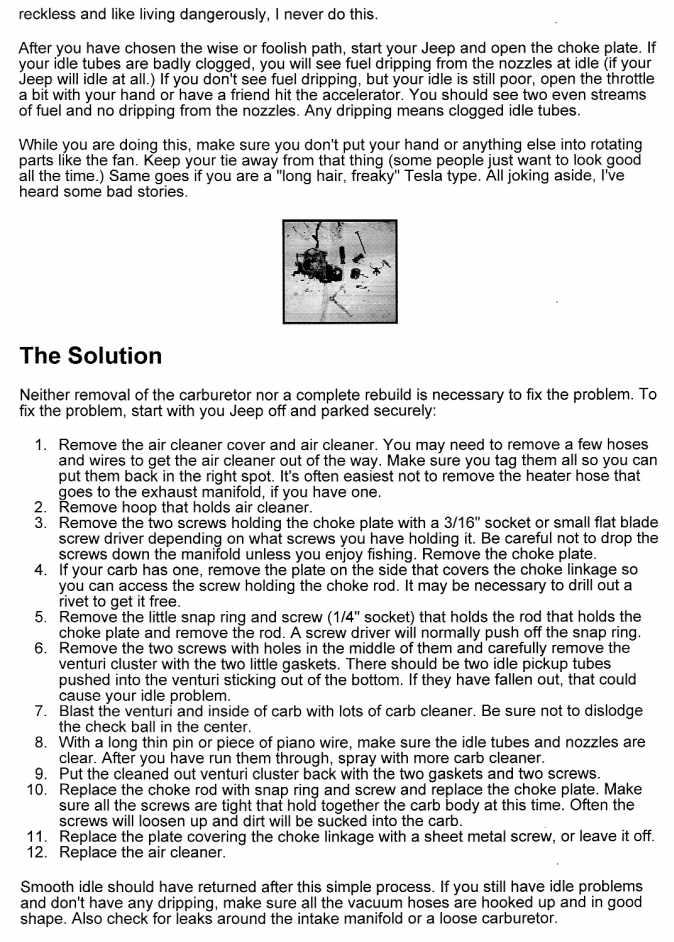Difference between revisions of "Curing Carter BBD Carb Issues"
Amcconcord (Talk | contribs) (→How to drill out Idle Jets to 0.032".) |
|||
| (4 intermediate revisions by 3 users not shown) | |||
| Line 6: | Line 6: | ||
[[Image:bbdclean03.jpg]] | [[Image:bbdclean03.jpg]] | ||
| + | |||
| + | |||
| + | == '''How to clean and Remove the Jeep/Eagle Carter BBD carb Idle jets,when running lean or stalls''' == | ||
| + | [https://www.youtube.com/watch?v=tT78XQa_zWc] '''How to remove Idle Jets, You Tube Video''' | ||
| + | |||
| + | '''Back Arrow Web Page when Video is Done!''' | ||
| + | |||
| + | == '''How to drill out Idle Jets to 0.032".''' == | ||
| + | [https://www.youtube.com/watch?v=TgQRggcC824] '''How to Drill out Idle Jets, You Tube Video''' | ||
| + | |||
| + | '''Back Arrow your web browser when Video is Done!''' | ||
| + | |||
| + | ''By K. Proulx 5/21/2016'' | ||
| + | |||
| + | |||
Latest revision as of 22:48, 21 May 2016
How to clean and Remove the Jeep/Eagle Carter BBD carb Idle jets,when running lean or stalls
[1] How to remove Idle Jets, You Tube Video
Back Arrow Web Page when Video is Done!
How to drill out Idle Jets to 0.032".
[2] How to Drill out Idle Jets, You Tube Video
Back Arrow your web browser when Video is Done!
By K. Proulx 5/21/2016
Lean BBD
By Skip Christenson
Running lean is a common problem with the Carter feedback BBD carb with CEC engine controls. Here’s how to test for the cause and adjust.
If you remember the days of metering rods and jets in carburetors, understanding this carburetor should be a cakewalk for you. For the newer etches who cut their teeth on injectors, think of this as the first generation idle air controller (IAC), but with an added function.
When, Shere And How
Jeep used the feedback Carter BBD on its 4.2 engines with CEC controls until 1990. To convert the BBD into a feedback version, Carter added a stepper motor to move two tapered metering pins. The stepper motor moves the metering pins in and out of two orifices (think of them as jets) to correspond to feedback the CEC computer receives from the input sensors.
The stepper motor has a range of 100 steps, but normally operates in the midrange. Both metering pins move at the same time, just like the metering rods in older 2bbl carburetors. However, unlike metering rods, these metering pins are different lengths and diameters. When installed in the carburetor, the pins are situated one above the other, with the main metering pin on top.
Also unlike conventional carburetors, you can look down the air horn of this carb and actually see the position of the main metering pin. That’s an important feature to remember when adjusting A/F mixture on this carburetor.
Inputs that the PCM Looks At To Determine Metering Rod Positioning:
1.Four-inch vacuum switch. No, it’s not 4 inches in length. It’s called that because it’s connected to ported vacuum and closes internal contacts any time vacuum measures above 4 inches Hg.
2.Ten-inch vacuum switch. Similar to the switch above, this one is connected to manifold vacuum and closes internal contacts when vacuum goes under 10 inches Hg.
3.O2 sensor. Standard single wire 0-1 volt sensor, with less than .5v indicating lean and above .5v indicating rich exhaust.
4.Air temperature switch. Thermal electric switch that switches closed below 58 degrees Fahrenheit, and open at all temps above 58 degrees Fahrenheit.
5.Coolant temperature switch. Thermal electric switch that switches open below 135 degrees Fahrenheit, and closed above 135 degrees Fahrenheit.
6.Wide open throttle switch. Electro-mechanical switch that closes when throttle is at wide-open throttle (WOT). (NOTE: This switch is not used on all cars.)
First Check the Position of the Metering Pins
To check for a lean condition, remove the air cleaner and look down at the top of the carburetor. Using the illustration to the right as a guide, determine where the main metering pin is.
As with other engine computer systems, the actuators only do what they are told —unless there is a mechanical malfunction of the actuator itself. So before you think about replacing the stepper motor and metering pins, first check all the sensors listed on the other side of this page.
If your examination of the metering pins shows that the metering pins are in the middle of the opening, or all the way toward the rear of the opening, the computer is commanding a lean condition. To diagnose a lean condition, check the O2, coolant temp switch, air temp switch, both vacuum switches and the wide open throttle switch.
If you see the metering pins pushed all the way forward, the problem is most likely not due to a sensor or computer problem. Check for a carburetor problem or a vacuum leak.
How To Set Idle Mixture After Repairing The System
With the engine at operating temperature, note the location of the main metering pin. If it is in the middle, you are ready to set the idle mixture. Unplug the stepper motor and then adjust the idle mixture to give you the lowest CO possible, without any rise in HC.
If the metering pin is not in the middle position, you need the computer to move it there. Add or subtract fuel and wait for the pin to show movement. Continue this until the pin is in the middle. Then, unplug the stepper motor and proceed as above.
Don’t forget to plug the stepper motor back into the harness.


